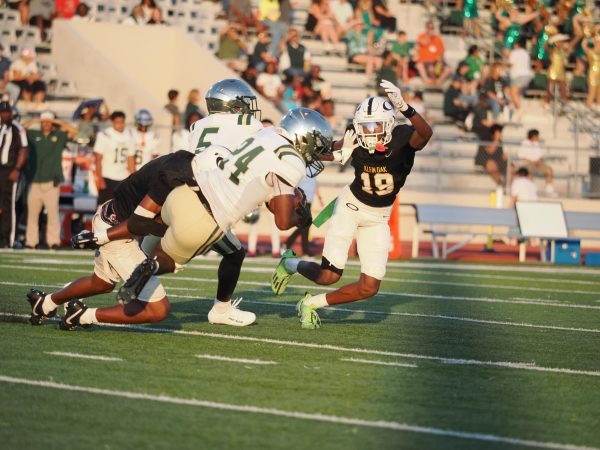Letters of S-U-C-C-E-S-S
Evolution of iconic letterman jackets bring tradition to Oak
Proudly striking a pose, Dezra Daduya shows off her traditional high school letterman jacket she earned through cross country, but she plans to add patches for orchestra and mariachi.
Very few pieces of clothing conjure that all-American image like the letterman jacket. It’s the dream of many students and athletes to don the status symbol the iconic letterman jacket as a testament for more than just athletes. For students who become eligible for the jacket and patches, it’s a clothing item worn with great pride, pomp, and circumstance. They represent both school and team pride and serve as a place to display personal awards, pins, badges, chenille patches and other accolades earned in athletics, academics or other activities.
“I have three patches with each team and year, a senior golf patch, an anthology patch, Distributive Education Clubs of America (DECA), a cross with Matthews 6:34 and a few more,” Avery Samuel said. “I’ve been a part of a lot of clubs and teams throughout high school and I think letterman jackets are a cool way of showing it. On the tail of my letterman, I have “worry later” because I tend to get stressed out and it’s a good reminder.”
According to American Madness, ironically the wool and the leather-sleeved jacket was originally a letterman sweater and its origins are traced to the athletic wear first worn by members of the Harvard University baseball team in 1865. Harvard’s baseball team at the time were the first known group of students to sew largely old English “H” patches onto their uniforms. The Harvard uniform was basically a thick-knitted gray flannel pullover and, with the giant “H” sewn right onto the center, these soon came to be known as “letterman” sweaters. On those sweaters, the letter was usually large and centered very different from how the letters, sportsman names, and other chenille patches are presented today.
“My patches are a couple of football patches from being on the team,” Jaxson Dicus said. “I have my football number seven on it as well. I have a panther and Texas flag to represent my roots and where I come from. I also have the scripture Psalms 23:4 to help me remember that God keeps me motivated.”
It wasn’t until the 1930s that the letterman jacket as we know it today was invented. During this time, the wool jacket with leather sleeves was introduced in response to a demand for sturdier clothing that could keep athletes warm. Borrowing the signature letter seen on its predecessor, the letterman jacket became a symbol of authority and reputation in school.
“Getting to have my own letterman is something I have always looked forward to,” Claire Baker said. “Being recognized for something I have been working really hard for always feels good. It makes me proud to wear it because all the extra work I put in is not going unnoticed.”
Following tradition, a player needed to prove their abilities on the field or reach a certain level of performance before they were “lettered” or awarded with a letter patch of the school’s initials. As the letterman tradition made its way from elite Ivy League universities down to high schools and other colleges in the United States, the term “varsity jacket” came into popularity. Soon, jocks across America were striving to wear a varsity jacket on their back.
As the varsity jacket began to enjoy widespread popularity, it started to cross over to mainstream popular culture as well. In 1983, Michael Jackson famously wore a red varsity jacket with gold leather sleeves in his music video for “Thriller.” From its privileged Ivy League origins, it landed on the backs of hip-hop groups like Run-D.M.C. and N.W.A, signifying the garment as one that now belonged to the streets. By then, it was clear that anyone could wear the varsity jacket, regardless of school affiliation or athletic prowess.
“I earned my letterman through performing in a bunch of plays and getting a lot of experience on stage,” Clayton Reel said. “For me, my letterman shows my commitment to my fine arts as well as other things I’m passionate about in school. It helps to show the things I’m proud of through my patches and helps show who I am.”
The letterman jacket is an iconic American tradition that, in addition to its utilitarian purpose of keeping you warm in winter, is becoming pieces of pride, a fashion statement, and even a fashion trend around the world.
“On top of being comfortable and warm, my letterman is a representation of who I am and what I have accomplished,” Michael Reynolds said. “It can also be something me and my parents hold onto as a keepsake forever once I leave for college.”









